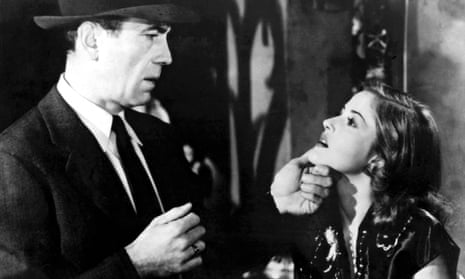Enter Philip Marlowe, one of the great characters in the Anglo-American novel, a protagonist to rival and possibly surpass Sherlock Holmes. Marlowe holds the key to the enduring appeal of this novel and the six that followed. In 1951, Chandler told his publisher, “It begins to look as though I were tied to this fellow for life.”
Maybe he should not have been surprised. Chandler fully understood the archetypal fictional detective, and had been polishing the character for years. In The Simple Art of Murder (1950) he describes such a man in a famous passage:
“He must be a complete man and a common man and yet an unusual man… He is a lonely man and his pride is that you will treat him as a proud man or be very sorry you ever saw him. He talks as the man of his age talks, that is, with rude wit, a lively sense of the grotesque, a disgust for sham, and a contempt for pettiness.”
Chandler might have been describing Philip Marlowe, who made his debut in this first novel, after several appearances in Chandler’s pulp fiction stories. He once observed of his celebrated style: “I’m an intellectual snob who happens to have a fondness for the American vernacular, largely because I grew up on Latin and Greek.”
Chandler, like PG Wodehouse, who will feature later in this series, had been educated at Dulwich College, a school founded by Edward Alleyn, the great actor-manager whose company, the Admiral’s Men, included the poet and playwright Christopher Marlowe, Shakespeare’s great rival. In Chandler’s stories, his protagonist also appears as “Mallory”. He is a 20th-century knight who treads the mean streets of Hollywood and Santa Monica, and who also visits the houses of the stinking rich, with their English butlers, corrosive secrets and sinister vices. Chandler plays with this medieval conceit in surreal metaphors. For instance: “It was a blonde to make a bishop kick a hole in a stained-glass window.”
In The Big Sleep – the title refers to the gangster euphemism for death – Marlowe is summoned to the home of old General Sternwood whose wild daughter, Carmen, is being blackmailed by a seedy bookseller. But The Big Sleep transcends its genre, moving WH Auden to write that Chandler’s thrillers “should be read and judged, not as escape literature, but as works of art”.
The plot, notorious for its complexity, soon spirals into a world of pornography, gambling and Hollywood lowlife. It’s not flawless, and there are some loose ends. When Howard Hawks filmed the novel he asked, “Who killed the chauffeur?” and Chandler replied that he had no idea. To him, plot was always subordinate to character, mood and atmosphere.
A note on the text
Chandler published his first detective story, in the pulp fiction magazine Black Mask, at the end of 1933. He explained this departure to his British publisher: “Wandering up and down the Pacific coast in an automobile I began to read pulp magazines, because they were cheap enough to throw away and because I never had at any time any taste for the kind of thing which is known as women’s magazines. This was in the great days of the Black Mask… and it struck me that some of the writing was pretty forceful and honest.” Between these beginnings and 1938, when he began to write The Big Sleep, he wrote 21 Black Mask stories, developing and honing the qualities of his mature work. A late starter, he came to this world as an outsider, a middle-aged English public schoolboy adrift in California. However, he caught on quick. The early stories have several Marlowe prototypes, LA settings, good and bad cops mixed into the regular crime cocktail of violence, drugs, sex and booze.
When he came to write The Big Sleep, Chandler “cannibalised” (his own description) his stories. The central plot of the novel comes from two stories, Killer in the Rain (published in 1935) and The Curtain (published in 1936). Both stories were standalone tales, sharing no common characters, but they had similarities. In each, there’s a strong father distressed by his wild daughter. Chandler melded the two fathers to make a new character and also did the same for the stories’ two daughters. There are other sources, too. Like Carmen Sternwood, his own much-loved wife Cissy had posed nude as a young woman and, like Carmen, taken opium. Marlowe’s alcohol problems reflect Chandler’s own latent alcoholism. In virtually every scene of a Chandler novel, someone is lighting a cigarette, or having a drink.
The Big Sleep was published in the spring of 1939. Despite collecting an impressive retinue of literary admirers, including Somerset Maugham and, later, Edmund Wilson, the Knopf (US) edition sold barely 13,000 copies, though it did better in France and England. It did not begin to attract serious international attention until after the appearance of Howard Hawks’s film starring Humphrey Bogart.
In 1959, the year of Chandler’s death, his great English admirer Ian Fleming permitted himself a discreet nod of homage. Towards the end of James Bond’s confrontation with Goldfinger, he passes through an airport and buys a book about golf – and the latest Chandler.
Three more from Raymond Chandler
Farewell, My Lovely (1940); The Little Sister (1949); The Long Goodbye (1953).
The Big Sleep is available in Penguin (£8.99). Click here to order it for £7.64

Comments (…)
Sign in or create your Guardian account to join the discussion